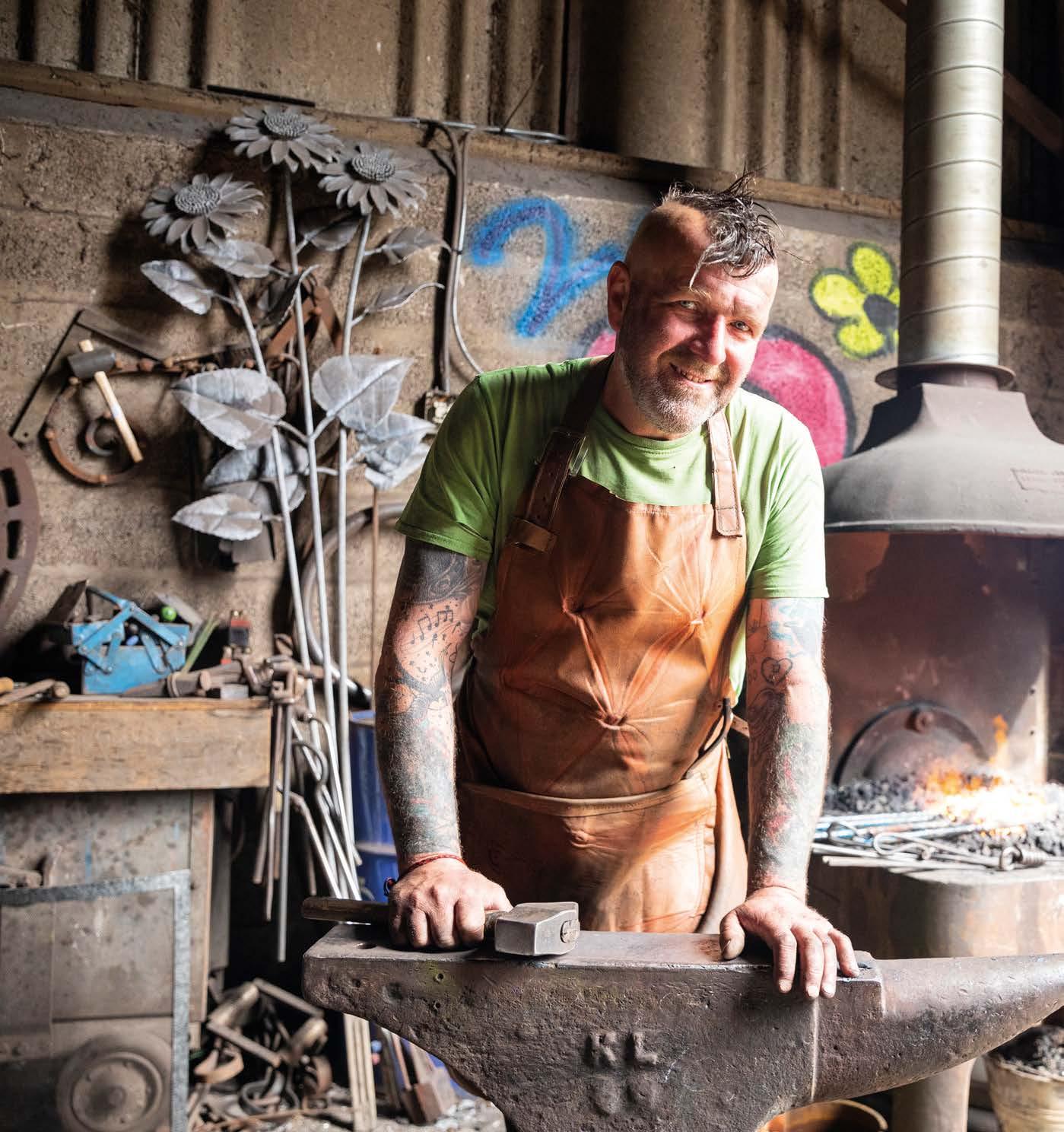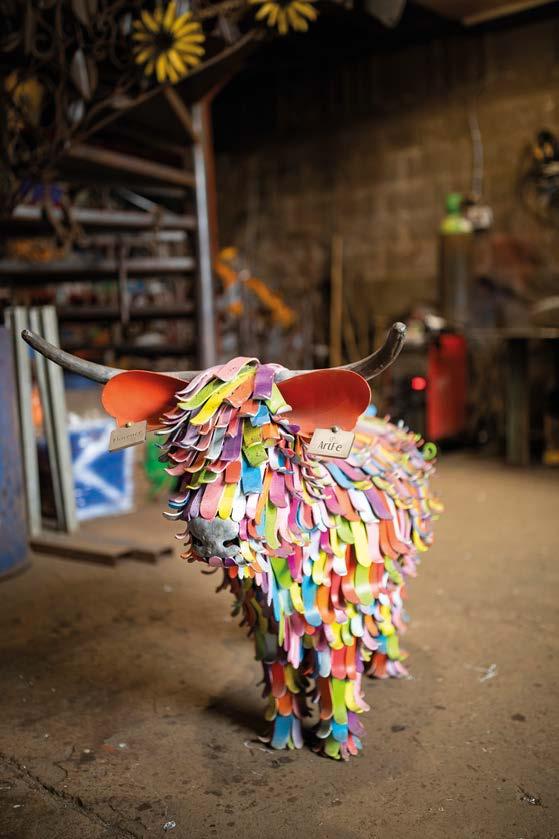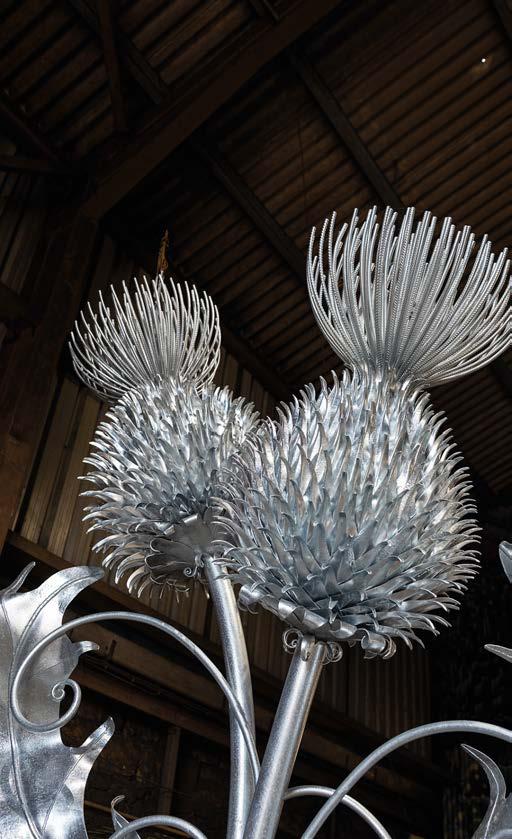
6 minute read
The king of metal
LEFT: Kevin Paxton began work as an apprentice blacksmith in 1989
Words and photos by JEREMY FLINT
Kevin Paxton is a blacksmith forging ahead with his creative inventions

The ancient art of blacksmithing has been around for centuries. In Scotland during the medieval period, blacksmiths were highly regarded and a staple of every town. Following the Industrial Revolution, the Scottish United Operative Blacksmiths’ Protective and Friendly Society was established in 1857 to support blacksmiths, which was later renamed the Associated Blacksmiths of Scotland in 1872 and the Associated Blacksmiths’ Forge and Smithy Workers’ Society in 1925.
Historically, blacksmiths worked with a forge or furnace to heat metal – shaping and joining together metal such as wrought iron, steel, brass, bronze and copper in the Scottish ‘smiddys’.
Despite the fall in demand for blacksmiths due to industrialisation, blacksmithing has enjoyed a resurgence in recent years, fuelled by modern appetites for crafting and sustainability, and modern-day blacksmiths continue to advance the trade into the future.
Kevin Paxton is a master blacksmith who preserves this ancient skill yet adds his own unique spin. With over 30 years’ experience, Kev has perfected his craft of transforming recycled, scrap metal and steel into stunning works of art by hand.
Kev discovered blacksmithing when he trained as an apprentice at a local smiddy after leaving school. He became fascinated with the job, often working long hours and weekends to develop his skills. He learnt the traditional blacksmithing techniques from a local blacksmith (and chairman of the British Artists Blacksmiths Association) who ran the business, passing down the family expertise gathered over generations.
Kev instantly felt at home in the smiddy and soon realised blacksmithing and making things with his hands was a natural fit. Coming from a working-class background, he recognised the need to work hard for a living and was grateful for this early chance in life when he could have easily taken the wrong turn.
Over the next 10 years, Kev mastered the craft and established his own business, K Paxton Blacksmith, in 1999 doing industrial work such as making decorative gates and some art. He evolved into a sculpture craftsman and formed ArtFe in 2010. Kev and his team of four now work at the old smiddy in Ratho, where ancient tools and pieces of metal hang in every corner of the workshop.
His work comprises a mix of public, private and
CLOCKWISE, FROM NEAR
RIGHT: Kevin and his team at ArtFe have created more than 300 Highland cattle sculptures; a giant thistle sculpture made from scrap metal; hidden details inspired by nature are often incorporated into Kevin’s designs; a human-sized scarecrow, which will go on display at the RHS Chelsea Flower Show; Kevin uses traditional blacksmithing techniques


commercial commissions, with clients including the artist Damien Hirst and Olympic Gold show jumping medallist, Scott Brash MBE.
Kev and his team have made close to 1,000 sculptures, including over 300 Highland cows and 150 thistles, besides other bespoke items, such as pigs, goats, sheep, giraffe, cats, springbok, octopus, and human sculptures of pirates and scarecrows. A 3.3m-tall horse and rider was made for Brash from 2.2 tonnes of horseshoes.
The skill and craftsmanship that goes into making the pieces is incredible. Kev likes to use the traditional, age-old blacksmithing techniques of shaping metal using fires, hammers and anvils. “Everything is hand-made, personalised and tailored to suit every client. Each product is unique, and I strive to do better every time I make something,” he says.
Initially, ideas are created from what the client wants and the environment where it will be on display. “A typical piece such as a Highland cow sculpture can take between 150-200 hours to complete” says Kev. The process involves a frame being built from a template where metal is heated and hammered into shape over an anvil before being welded.
The constituent parts are made by hand where small pieces of metal that form the sculpture are cut, chiselled and shaped before Kev sets to work on designing and making the creation with a welder.



Lastly, modern techniques like galvanising (a hot zinc bath to prevent rusting) and acid washing (to burn off purities and prevent corrosion) are applied to help create individual and enduring finishes. “The aim of our work is to make people smile” says Kev.
Some of the latest creations include a human-sized scarecrow (valued at £30,000), a giant thistle and Highland cows that will be on display at the RHS Chelsea Flower Show in September 2021. The sculptures are usually environmentally friendly: “The thistle is made of metal salvaged locally from two diesel cars, two old lamp posts and reinforcing bars,” says Kev.
Kev’s inspiration comes from a respect for mother nature and he likes to show his love of the countryside in his work, where he will encourage you to think about your relationship with the natural environment. He includes wildlife and hides certain features in his sculptures.
For example, the scarecrow made for the Chelsea Flower Show has a robin on one arm and a hidden mouse placed inside the scarecrow’s hat for people to discover. He says, “I love to reflect the excitement and fascination I felt the very first time I saw the hidden aspects of the natural world on a bird-watching field trip as a child.”
With the value of metal going up and an increased demand for garden sculptures, the industry is thriving. According to Kev: “over the last 18 months the pandemic and periods of no travel have increased our work for garden sculptures as more people are spending time in their gardens.”
He loves to attend shows and art fairs to sell and showcase his work, including the Royal Highland Show and RHS Hampton Court Palace Garden Festival, where he is making a name for creative metal sculptures.
Kev also supports charities and finds value in giving one in six pieces to charity. Every year, he donates a sculpture to the charity It’s Good 2 Give to raise funds for children with cancer.
When a Highland cow sold at the charity ball auction for £22,000 in 2019, someone offered to match the bid, raising £44,000 for the charity.
Another side-line of Kev’s amazing achievements is working as an artisan on the TV programmes Money for Nothing and Scrap Kings, where he turns old junk metal into art forms and items such as decorative mirrors.
Although getting burnt daily is part of the job, Kev is driven by keeping his clients and staff happy and continuing his passion, which is evident in all the magnificent sculptures he produces, long may this continue. S
If you would like to find out more about Kevin’s work or commission a piece yourself, go to artfe.co.uk










